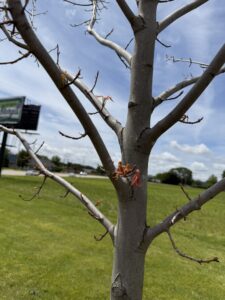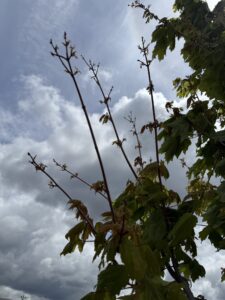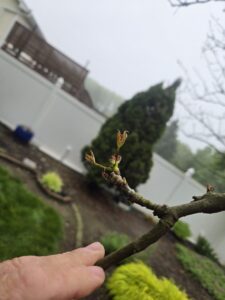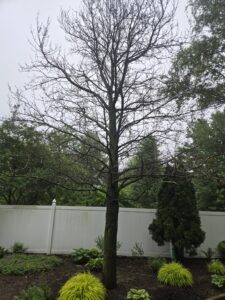Diagnosing abiotic (non-living) problems in plants can be challenging due to the many interacting factors and varying levels of plant tolerance. In many cases, reviewing the recent weather history of a given area provides valuable insight into the possible causes of observed symptoms.
Over the past few weeks, several samples submitted to the Purdue Plant and Pest Diagnostic Laboratory (PPDL) have shown signs of delayed and sporadic budbreak. While most of the affected trees have eventually leafed out, a few have failed to produce any leaves at all. The species reported so far include maple, tulip poplar, and sweetgum—all from locations in northern Indiana. After ruling out typical causes such as drought stress, herbicide injury, and biotic agents (insects or pathogens), we focused on weather-related factors.
- Figure 1. Maple with delayed and sporadic budbreak 2025. These trees were planted in Northern Indiana in the spring of 2024 and were watered properly until the end of October of 2024.
- Figure 2. Maple with delayed and sporadic budbreak in 2025. These trees were planted in Northern Indiana in the spring of 2024 and were watered properly until the end of October of 2024.
Winter Cold? Not Likely
Our first step was to examine whether extreme low temperatures could have caused cold injury. The lowest temperature recorded in the South Bend area during the 2024–2025 winter was -5°F. All of the reported species are hardy to USDA Zones 3 to 5, tolerating temperatures as low as -20°F to -35°F. Thus, absolute winter lows were not cold enough to cause the observed symptoms.
Fall and Spring Temperature Fluctuations
This brings us to a more likely explanation: temperature fluctuations during the transitions into and out of dormancy. Deciduous trees are particularly vulnerable during early fall and late spring, when they are neither fully dormant nor yet fully active. Similar patterns of injury were seen during the winter of 2022–2023 (read more here).
In fall, decreasing daylight and declining temperatures trigger dormancy in temperate trees. To come out of dormancy and resume growth in spring, plants must first accumulate a sufficient number of chilling hours—typically defined as the number of hours between 32°F and 45°F (0°C to 7°C)—before they begin accumulating growing degree days (GDDs).
Chilling hours act as a biological “reset,” removing internal growth inhibitors that prevent premature budbreak. Without enough chilling, plants may break dormancy unevenly, show delayed growth, or fail to grow normally.
Species-Specific Chilling Requirements
Different species—and even cultivars—have different chilling requirements. Here are some general ranges:
- Sugar maple (Acer saccharum): 1,000–1,200 chilling hours
- Tulip poplar (Liriodendron tulipifera): 800–1,000 chilling hours
- Sweetgum (Liquidambar styraciflua): 600–1,000 chilling hours (less for southern-adapted varieties)
If these chilling requirements aren’t met, symptoms may include:
- Delayed budbreak
- Reduced flowering or fruit set
- Uneven or poor leaf emergence
- Reduced overall vigor
- Figure 3. Delayed budbreak on sweetgum located in Northern Indiana.
- Figure 4. Delayed and sporadic budbreak on sweetgum in Northern Indiana.
Chilling Hours Were Adequate in 2024–2025
Data from Valparaiso shows that approximately 1,395 chilling hours accumulated between November 2024 and April 2025—more than enough for the species in question. Research has shown that increased chilling hours reduce the number of GDDs needed for budbreak (Thibault et al., 2020), suggesting chilling deficiency is not to blame in this case.
So, What Happened?
The most probable cause of this year’s delayed and inconsistent budbreak is the “start-stop” weather pattern observed during spring 2025. As temperatures warmed, some buds initiated growth, only to be halted by subsequent cold snaps. These interruptions can severely slow development, and in some cases, cold injury to tender emerging buds may occur.
What You Can Do
If you have a tree exhibiting delayed or sporadic budbreak this year, consider submitting a sample to the Purdue Plant and Pest Diagnostic Laboratory for analysis. Instructions for submission are available here:
Submit a sample to PPDL
Related articles:
Effects of Recent Cold Temperatures on Plants
https://purduelandscapereport.org//article/effects-of-recent-cold-temperatures-on-plants/
Effect of Cold Temperatures During Bud Break
https://purduelandscapereport.org//article/4227/
What do Trees Do in the Winter
https://purduelandscapereport.org//article/what-do-trees-do-in-the-winter/
Winter Injury Could Cause a Reduction of Flowering on Perennial Trees and Shrubs
2020 Has Jumped the Shark!
https://purduelandscapereport.org//article/2020-has-jumped-the-shark/
Winter Injury Update to Michigan Trees and Shrubs
https://purduelandscapereport.org//article/winter-injury-update-to-michigan-trees-and-shrubs/
References:
Anderson, J.L., Seeley, S.D., & Richardson, E.A. (1986). Phenological responses of deciduous fruit trees to climatic factors. Acta Horticulturae, 184, 93–104. https://doi.org/10.17660/ActaHortic.1986.184.12
Caffarra, A., & Donnelly, A. (2011). The ecological significance of phenology in four different tree species: Interactions with temperature and photoperiod. Climate Research, 49(2), 127–140. https://doi.org/10.3354/cr01024
Erez, A., Fishman, S., Linsley-Noakes, G.C., & Allan, P. (1990). The dynamic model for rest completion in peach buds. Acta Horticulturae, 276, 165–174. https://doi.org/10.17660/ActaHortic.1990.276.21
Farmer, R.E., & Reinartz, J.A. (1986). Growth and dormancy responses to temperature in populations of sweetgum (Liquidambar styraciflua) from different latitudes. Tree Physiology, 1(3), 185–192.
Faust, M., & Erez, A. (1987). The physiology of dormancy in temperate zone fruit trees. Horticultural Reviews, 9, 204–243.
Hänninen, H. (1990). Modelling bud dormancy release in trees from cool and temperate regions. Acta Forestalia Fennica, 213, 1–47. https://doi.org/10.14214/aff.7685
Kramer, K. (1994). A modeling analysis of the effects of climatic warming on the probability of spring frost damage to tree species in The Netherlands and Germany. Plant, Cell & Environment, 17(4), 367–377. https://doi.org/10.1111/j.1365-3040.1994.tb00305.x
Kvaalen, H., & Johnsen, Ø. (2008). Timing of bud set and bud burst in provenances of Norway spruce grown under different temperature regimes. Tree Physiology, 28(3), 311–318.
Luedeling, E., Kunz, A., & Blanke, M.M. (2013). Identification of chilling and heat requirements of cherry trees—a statistical approach. International Journal of Biometeorology, 57, 679–689. https://doi.org/10.1007/s00484-012-0594-y
Murray, M.B., Cannell, M.G.R., & Smith, R.I. (1989). Date of budburst of fifteen tree species in Britain following climate warming. Journal of Applied Ecology, 26(2), 693–700. https://doi.org/10.2307/2404093
Richardson, E.A., Seeley, S.D., & Walker, D.R. (1974). A model for estimating the completion of rest for ‘Redhaven’ and ‘Elberta’ peach trees. HortScience, 9(4), 331–332.
Thibault, E., Soolanayakanahally, R., and Keller, S. 2020. Latitudinal clines in bud flush phenology reflect genetic variation in chilling requirements in balsam poplar, Populus balsamifera. American Journal of Botany. 107 (11): 1597-1605.



